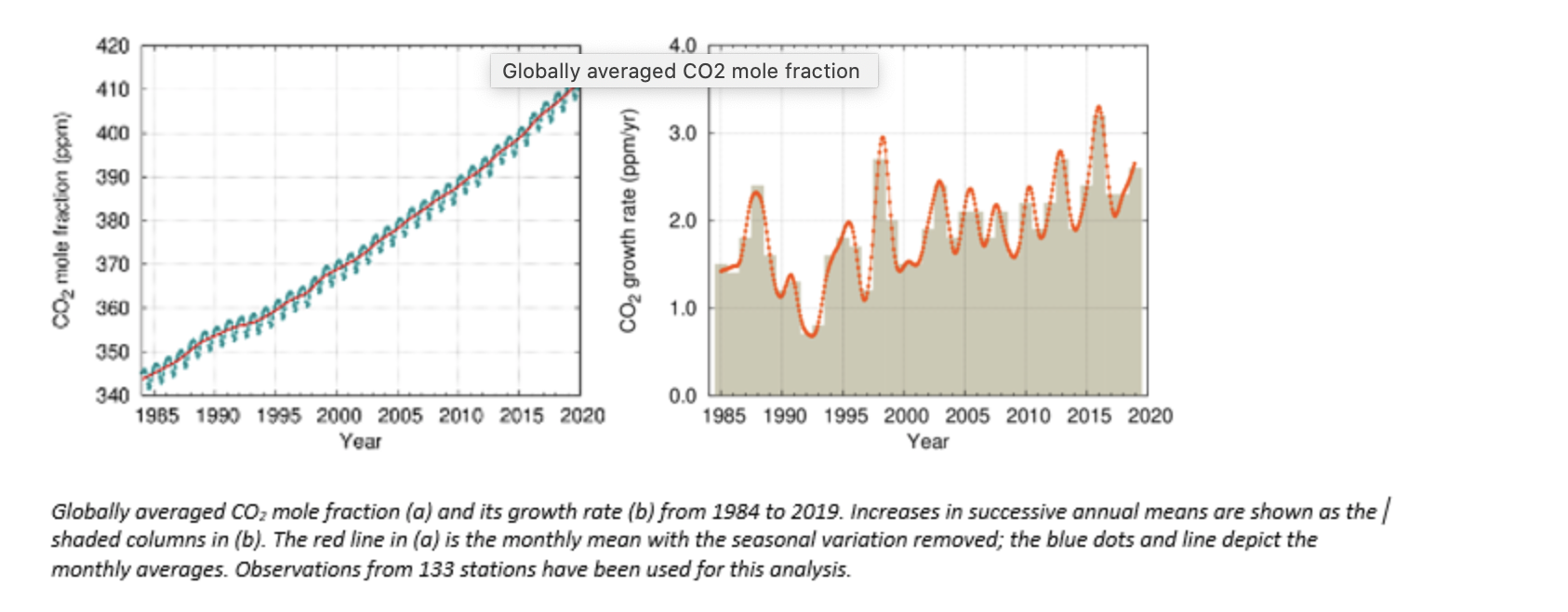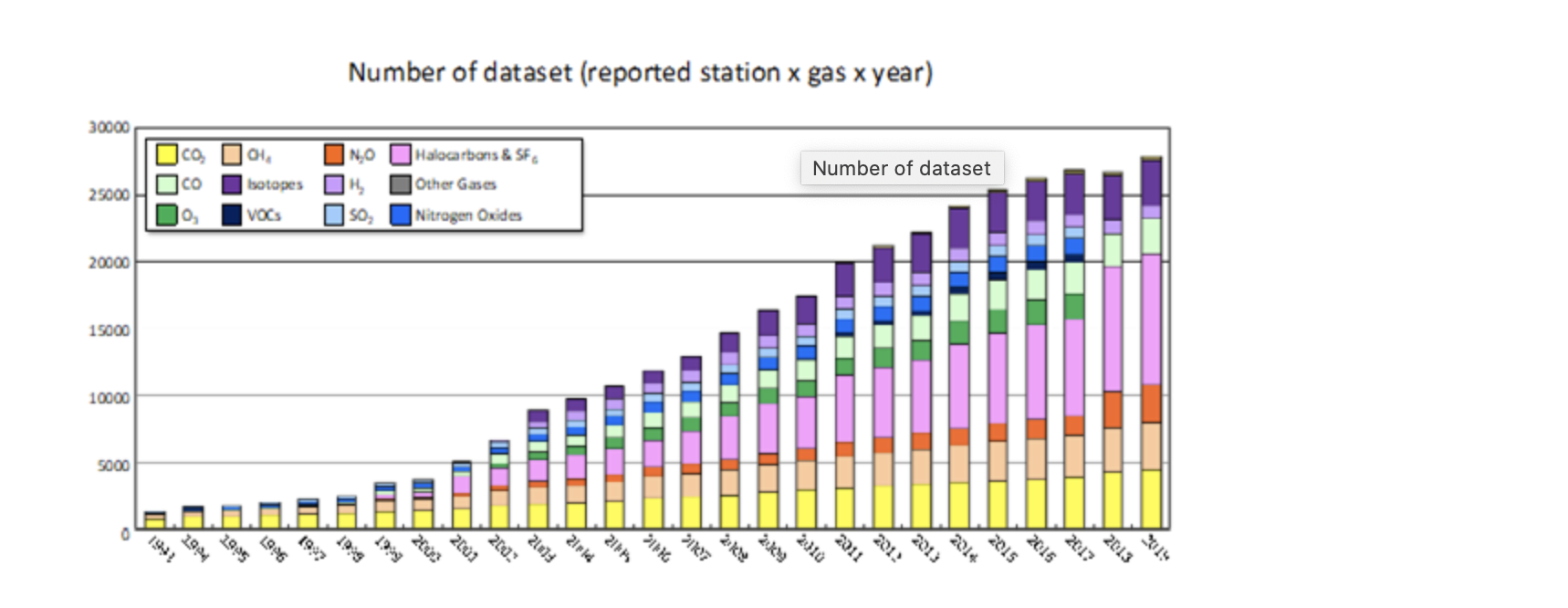The industrial slowdown due to the Covid-19 pandemic has not curbed record levels of greenhouse gases which are trapping heat in the atmosphere, increasing temperatures and driving more extreme weather, ice melt, sea-level rise and ocean acidification.
The lockdown has cut emissions of many pollutants and greenhouse gases such as carbon dioxide. But any impact on CO2 concentrations – the result of cumulative past and current emissions – is in fact no bigger than the normal year-to-year fluctuations in the carbon cycle and the high natural variability in carbon sinks like vegetation.
Carbon dioxide levels saw another growth spurt in 2019 and the annual global average breached the significant threshold of 410 parts per million (ppm), according to the WMO Greenhouse Gas Bulletin. The rise has continued in 2020. Since 1990, there has been a 45% increase in total radiative forcing – the warming effect on the climate – by long-lived greenhouse gases, with CO2 accounting for four fifths of this.
“Carbon dioxide remains in the atmosphere for centuries and in the ocean for even longer. The last time the Earth experienced a comparable concentration of CO2 was 3-5 million years ago, when the temperature was 2-3°C warmer and sea level was 10m-20m higher than now. But there weren’t 7.7 billion inhabitants,” says WMO secretary general Professor Petteri Taalas.
“We breached the global threshold of 400 parts per million in 2015. And just four years later, we crossed 410ppm. Such a rate of increase has never been seen in the history of our records. The lockdown-related fall in emissions is just a tiny blip on the long-term graph. We need a sustained flattening of the curve.”
“The Covid-19 pandemic is not a solution for climate change. However, it does provide us with a platform for more sustained and ambitious climate action to reduce emissions to net zero through a complete transformation of our industrial, energy and transport systems. The needed changes are economically affordable and technically possible and would affect our everyday life only marginally. It is to be welcomed that a growing number of countries and companies have committed themselves to carbon neutrality,” he said. “There is no time to lose.”

2020 trends
The Global Carbon Project estimated that during the most intense period of the shutdown, daily CO2 emissions may have been reduced by up to 17% globally due to the confinement of the population. As the duration and severity of confinement measures remain unclear, the prediction of the total annual emission reduction over 2020 is very uncertain.
Preliminary estimates indicate a reduction in the annual global emission between 4.2% and 7.5%. At the global scale, an emissions reduction this scale will not cause atmospheric CO2 to go down. CO2 will continue to go up, though at a slightly reduced pace (0.08-0.23ppm per year lower). This falls well within the 1ppm natural inter-annual variability. This means that on the short-term the impact of the Covid-19 confinements cannot be distinguished from natural variability, according to the Bulletin.
New records in 2019
The Greenhouse Gas Bulletin – one of WMO’s flagship reports – provides details on atmospheric abundance of the main long-lived greenhouse gases: carbon dioxide, methane and nitrous oxide.
The Bulletin is based on observations and measurements from WMO’s Global Atmosphere Watch and partner networks, which include atmospheric monitoring stations in remote polar regions, high mountains and tropical islands. These stations have continued to function despite Covid-19 restrictions hampering resupplies and rotation of staff in often harsh and isolated locations.

CO2
Carbon dioxide is the single most important long-lived greenhouse gas in the atmosphere related to human activities, contributing about two thirds of the radiative forcing. The annual globally averaged level of carbon dioxide was about 410.5ppm in 2019, up from 407.9ppm in 2018, having crossed the 400 ppm benchmark in 2015. The increase in CO2 from 2018 to 2019 was larger than that observed from 2017 to 2018 and also larger than the average over the last decade.
Emissions from combustion of fossil fuels and cement production, deforestation and other land-use change pushed 2019 atmospheric CO2 to 148% of the pre-industrial level of 278ppm, which represented a balance of fluxes among the atmosphere, the oceans and the land biosphere. During last decade about 44% of CO2 remained in the atmosphere, while 23% was absorbed by the ocean and 29% by land, with 4% unattributed.
The Greenhouse Gas Bulletin is based on global average figures for 2019. Individual stations have shown that the upward trend continues in 2020. Monthly average CO2 concentrations at the benchmark station of Mauna Loa, Hawaii, were 411.29ppm in September 2020, up from 408.54ppm in September 2019. At Cape Grim in Tasmania (Australia), the respective figures were 410.8ppm in September 2020, up from 408.58ppm in 2019.

Methane, a powerful greenhouse gas which remains in the atmosphere for less than a decade, was 260% of pre-industrial levels in 2019 at 1,877 parts per billion. The increase from 2018 to 2019 was slightly lower than that observed from 2017 to 2018 but still higher than the average over the last decade.
Methane contributes about 16% of the radiative forcing by long-lived greenhouse gases. Approximately 40% of methane is emitted into the atmosphere by natural sources (e.g. wetlands and termites), and about 60% comes from anthropogenic sources (e.g. ruminants, rice agriculture, fossil fuel exploitation, landfills and biomass burning).
Nitrous oxide, which is both a greenhouse gas and ozone depleting chemical, reached 332.0 parts per billion in 2019, or 123% above pre-industrial levels. The increase from 2018 to 2019 was also lower than that observed from 2017 to 2018 and practically equal to the average growth rate over the past 10 years.
Several other gases are also presented in the Bulletin, including the ozone depleting substances regulated under the Montreal Protocol.

The WMO Global Atmosphere Watch Programme coordinates systematic observations and analysis of greenhouse gases and other atmospheric constituents. Greenhouse gas measurement data is archived and distributed by the World Data Centre for Greenhouse Gases (WDCGG) at the Japan Meteorological Agency, which celebrates its 30th anniversary in 2020.
A separate and complementary Emissions Gap Report by UN Environment will be released on December 9, 2020. The Emissions Gap Report assesses the latest scientific studies on current and estimated future greenhouse gas emissions; they compare these with the emission levels permissible for the world to progress on a least-cost pathway to achieve the goals of the Paris Agreement. This difference between “where we are likely to be and where we need to be” is known as the emissions gap.
The Global Carbon Project will release its annual update of the global carbon budget and trends in December.
This article was originally published here.


